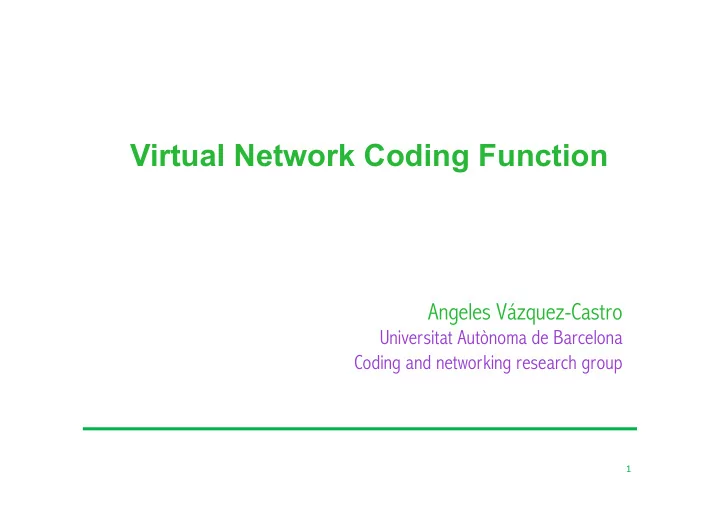

Virtual Network Coding Function Angeles Vázquez-Castro Universitat Autònoma de Barcelona Coding and networking research group 1 ¡
Objectives 1. Concept of network coding. 2. Design of network coding as a VNF. 3. Get feedback from NFVRG. 2 ¡
Objectives 1. Concept of network coding. 2. Design of network coding as a VNF. 3. Get feedback from NFVRG. 3 ¡
Concept Theorem (Elias, Feinstein, Shannon, 1956). Max-flow Min-cut. Maximum amount of information flow passing from source s to sink t is equal to the capacity of the minimum cut-set. -Based on energy conservation law. -Basis of current Internet, store-and-forward nodes. Theorem (Ahlswede, Cai, Li, Yeung, 2000). Multicast Max-flow Min-cut. Maximum amount of information flow passing from a source s to every ti multicast destination is equal to the minimum value among all cut-sets. -NOT based on energy conservation law. -NOT based on store-and-forward, but on network coding. 4 ¡
Li et Al. (2003) and Ho et Al. (2003/06) Koetter, Medard (2002/03) o Linear coding is enough to achieve multicast capacity. o Random linear coding (random selection of a ij ) is enough to achieve multicast capacity. o Purely algebraic coding solvability. Networking becomes solving linear relations between input flows (X) and output flows (Z). 5 ¡
Z=MX Z=MX Z=MX M = ATB T From ¡R. ¡Koe+er ¡and ¡M. ¡Médard, ¡“An ¡algebraic ¡approach ¡to ¡network ¡coding”, ¡2003. ¡ 6 ¡
General benefits and cost o Increases throughput, reduces delay. o Better use of network resources (efficiency). o Reduced computational complexity compared to routing. o Robustness to/detection of link failures. o Enables in-network engineering of packet flows. o The concept of network coding can be applied at any communication layer, including physical layer. o Additional overhead due to coding coefficients. o Requires novel design paradigms and possibly gradual implementation/deployment. o Patents for some things in some countries. 7 ¡
Examples o TCP/IP native leads to network congestion o NC enables faster TCP and lower congestion. o P2P file sharing/content distribution o Avalanche (Microsoft): BitTorrent-like with NC. o Big file to randomly coded small pieces . o Participants share coded pieces. o Higher throughput, easy scheduling, lower delay. o Instant messaging o Alternative to flooding (informative packets). o (Passive) network tomography o Topology inference. o Distributed storage. 8 ¡
Types of errors in network-coded networks o Random errors o Tackled classically on a link-by-link basis. o Either errors are corrected or the packet is discarded. o Erasure errors o Due to underlying protocols (e.g. congestion). o Malicious nodes o Packets may be altered by malicious nodes. o Exogenous packets may be injected to interfere communication. o Errors in headers o Any error in the header may cause crucial information to be lost. o Different approaches 9 ¡
Non-coherent approach: Kötter, Silva, Kschischang, 2008-2011 o Two separated problems (“non-coherent”): o Network coding problem. o Error correction problem. o Network matricial channel (linear operator channel) o Adversarial error model. 10 ¡
Constructions o Subspace coding (codewords are subspaces!). o Novel construction approaches, e.g.: o With certain automorphism group. Etzion, Vardy, 2011. o Spread codes. Manganiello, Gorla, Rosenthal, 2008. o Orbit codes. Magianello, Trautmann, Rosenthal, 2011. o Based on Schubert Calculus and Plücker coordinates. Trautmann, Silberstein, Rosenthal, 2013. o Multilevel construction. Etzion, Silberstein, 2009. o Constructions based on q-analog designs. Full list at www.network-coding.eu/ 11 ¡
Objectives 1. Concept of network coding. 2. Design of network coding as a VNF. 3. Get feedback from NFVRG. 12 ¡
From coding to networking Telecom Theoretical Coding theorist/ Networking/computer computer scientist algebraist engineer scientist 13 ¡
From coding to networking ¡ Today ¡ Coming up (Network coding view) ¡ Non-‑physical ¡network ¡informa5on ¡flow ¡ Func=ons/Computa=ons ¡ Virtualiza=on ¡ Physical ¡network ¡informa=on ¡flow ¡ 14 ¡
Proposal: network coding functional architecture ¡ o Follow up of ideas in NWCRG. o European COST Action on network coding o Invited SPAWC’16 paper o “Network Coding Function Virtualization” o NetWorld2020 whitepaper o Support to 5G PPP initiative. Validating scenario o Geo-Vision H2020 project. o 15 ¡
Proposal: network coding functional architecture ¡ o Approach combines o System-oriented (ITU/ETSI). o Network-oriented (e.g. IETF/IRTF ). o Functional architecture (preliminary ideas presented at NWCRG) o Coding functionalities: o Logical interpretation of coding use. o Coding for flow computation/manipulation. o Information flow engineering functionalities o Adaptation. o Optimization o Resource Allocation. o Spatial computation. o Physical/virtualization functionalities o Storage, interaction physical/virtual. 16 ¡
NC functional architecture ¡ Coding ¡func5onality ¡ Virtual ¡Network ¡Coding ¡Func=on ¡ NC ¡ NC ¡ NC ¡logic ¡ codebooks ¡ opera=ons ¡ NC ¡architectural ¡ ¡ Design ¡framework ¡ Informa5on ¡flow ¡engineering ¡func5onality ¡ ¡ ¡ NC ¡op=miza=on ¡ NC ¡adapta=on ¡ Interoperability ¡ System ¡ external ¡ Physical/Network/System ¡abstrac=ons ¡ func=onali=es ¡ Physical/virtualiza5on ¡func5ons ¡ ¡ NCFV ¡ ¡ ¡ NC ¡storage ¡ reconfigurability ¡ NC ¡ Domains ¡ Network ¡ ¡ ¡ Coding ¡ ¡ Domain ¡ ¡ VNC NCF F ¡ Mathema=cal ¡ Func5onal ¡ ¡ models ¡ Domain ¡ ¡ ¡ ¡ Protocol ¡ ¡ Design ¡ ¡ Domain ¡ ¡ objec=ves ¡ 17 ¡
Validation scenario ¡ o H2020 ¡Geo-‑Vision ¡project: ¡geo-‑network ¡coding ¡ solu=ons ¡for ¡communica=ons ¡involved ¡in ¡UN ¡ opera=ons, ¡civil ¡protec=on ¡and ¡law ¡enforcement. ¡ o Galileo-based geo-spatial control of reliability . o Coding functionality: systematic network coding. o Optimization functionality based on reducing energy consumption and complexity. o Analytical (spatial) model for orchestration. 18 ¡
To take home ¡ o Network coding and coding for network coding are both coding concepts and networking design tools. o Check codes at www.network-coding.eu/ . o Applicable to real packet networks for the control and optimization of the information flow. o Across layers. o Across networks. o Functional architecture enables the design of virtual network coding function(s). 19 ¡
Objectives 1. Concept of network coding. 2. Design of network coding as a VNF. 3. Get feedback from NFVRG. Thank you! 20 ¡
Recommend
More recommend